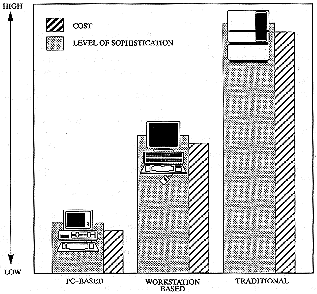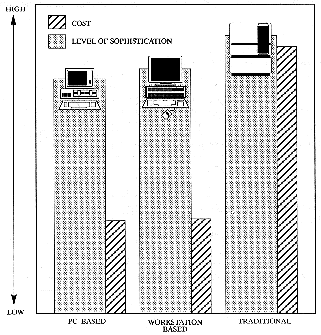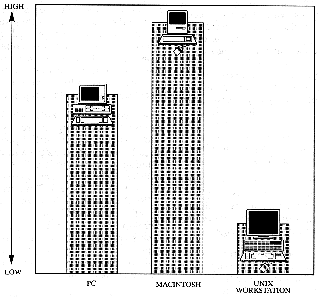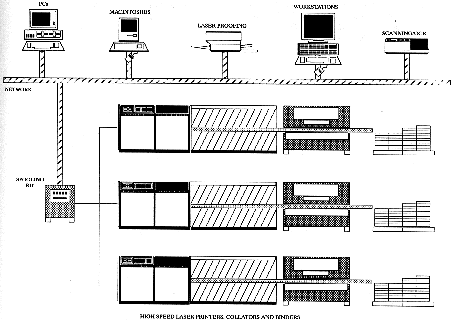
 |
The emergence, in the 1980s of low cost, sophisticated computer aided publishing systems allowed organisations which were involved in the development and preparation of course texts, training manuals and other instructional materials to manage and monitor the total preparation of print materials within their own environments.This paper will discuss the impact of these do it yourself (D-I-Y) publishing systems on the quality of distance education materials being produced, especially in terms of the typographic formats which have been adopted. The emergence of desktop publishing technologies will be discussed with respect to the hardware and software upon which they have been based, and the current state of the software will be expanded upon. Also some assumptions will be made regarding the future directions of the desktop technologies.
The purpose of this presentation is to stimulate discussion as to how desktop publishing is being managed and also how the future of desktop publishing and its enhanced capabilities will impact upon the production of distance education courseware.
The successful introduction of laser printing encouraged many software developers to begin the development of typesetting/publishing packages which would run not only on the Macintosh, but also on other existing hardware platforms. As a consequence, programs with varying levels of sophistication became available for the IBM personal computer and its growing number of clones, as well as the larger engineering (Unix) workstations. There was, of course, much value in being able to offer the flexibility to publish documents without the expense of further hardware (except a laser printer if high quality output was a requirement).
It would seem that one of the major priorities of the software developers was to demystify the typesetting and publishing process. This was done by providing an elementary user interface using mouse controlled menus for interactivity. As a consequence, the term user friendly became synonymous with desktop publishing systems.
When these publishing systems were developed on a variety of hardware platforms, the term desktop publishing became more specific to the personal computer approach to publishing, whereas computer aided publishing became a more universal term in referring to the range of both traditional and non-traditional publishing technologies available. At this point, computer aided publishing encompassed three levels of publishing systems:
Although the purchase of workstations for the sole purpose of publishing was viewed as somewhat of an "overkill", the initial purchasers have not had to suffer the problem of insufficient memory and speed - all too common with the personal computers of 3-4 years past.
For the newcomers to desktop publishing, the major advantage of this technology was its ease of use especially at the PC level. For the professional publisher, however, systems developed at the PC level in early days of desktop publishing provided very few of the typographic intricacies (for example leading, justification and kerning) which can greatly affect the readability and aesthetic appeal of the published work. During the initial years of desktop publishing, the three levels of systems described above were clearly distinct in terms of their complexity.

Figure 1: A comparison of costs and sophistication of the
three levels of desktop publishing, 1985/86.
The upgrading of word processing systems to desktop publishing was perhaps one of the most beneficial applications of this technology in the distance education publishing environment and, as a consequence, typing pools soon evolved into in house publishing departments.
When desktop publishing was made available to the open market, ease of use was a major consideration in the design of the publishing software. The "What You See Is What You Get" (WYSIWYG) display was a fundamental step towards user friendliness and it was this ability to easily control the elements on the screen which made the systems so attractive to the first time user.
The inference that anyone could publish using the desktop systems resulted in a proliferation of printed educational materials which, in many cases, were devoid of the essential typographic characteristics which play a major role in determining not only the aesthetic appeal, but more importantly the readability of the printed piece. This is quite understandable (although not forgivable) if one considers the particular responsibilities (traditionally the domain of the publisher/printer) which have been taken over by these non-traditional publishers.
While newly installed publishing systems offered an enormous degree of typographic flexibility in comparison to the superseded word processor, it soon became apparent that if there was no control over the operator's, and the author's, use of these facilities, there would be, ironically, a degradation in the quality of instructional materials produced. In order to develop a coherent style, both the typographer and the instructional design team required an intimate knowledge of the functionality of the publishing system. A typographic style was seen as essential for a variety of reasons:

Figure 2: The skills/responsibilities of personnel involved in the publishing process.
Highlighted are those which can now be controlled by the desktop publisher.
With the availability of a greater range of typographic features and page formats, authors and instructional designers now had the opportunity for more creative expression and enterprise in the design of instructional materials. Whilst the presentation of material has been contained within the requirement of this institution's Style Guide, there has been a noticeable increase in the use of the graphic features of the desktop publishing software. Tables, graphs, charts, illustrations and icons are all being used by authors who are showing greater interest in exploring improved and alternative methods of displaying their instructional texts. The outcome has been that the instructional materials are now far more sophisticated than ever before, however it is still not fully appreciated by authors that the effectiveness of their materials is greatly dependent upon expert instructional and typographic design input.

Figure 3: A comparison of costs and sophistication across the three levels of publishing, 1990.
While only four years ago, publishing professionals were concerned that the desktop systems lacked many of the most fundamental typographic elements, the systems of 1990 offer typographic flexibility comparable to the most sophisticated traditional publishing systems. Moreover, the desktop systems are significantly less expensive.

Figure 4: A comparison of desktop publishing software across various platforms, 1990.
The development of desktop publishing software has been mainly aimed at the microcomputer level simply because this is the larger user base. Currently there is more publishing related software available for the Macintosh than any other PC although there has been much rewriting of existing packages to run on alternative PC platforms.
The requirement for desktop publishing features have become so significant in software development that the latest versions of basic word processing programs contain pull down, mouse controlled menus and graphics manipulation tools as standard features.
Paralleling developments in publishing software, there has been dramatic developments in hardware - especially at the microcomputer level. Whereas four years ago those contemplating professional desktop publishing would not have considered a Macintosh or PC purely on the grounds of computing power, the incorporation of the latest high speed microprocessors from Intel and Motorola ensure that today's microcomputers compete admirably with Unix workstations.
While many may rejoice that these high end microcomputers are now competing on equal terms with the engineering workstations, there are some noteworthy disadvantages:
These composition skills, which are essential in ensuring the readability and aesthetic appeal of the product, already exist with tradespersons in the printing industry and it is these skills which have become quite a marketable product. While many institutions have enlisted the services of a typographer or graphic designer to aid in the development of a publishing style, others continue to allow the content experts to determine the presentation style of their materials (often at the expense of readability).
The printing and publishing industry still sets the standard regarding the quality of print design and, in trying to emulate that standard, the higher quality end of the desktop publishing industry has made enormous progress in producing exemplary materials. This increase in quality is not necessarily due to greater sophistication of desktop software, but moreover from a realisation that higher quality design, and not simply typesetting, is necessary to compete with the traditional printed industry.
Because desktop publishing offers educators greater instructional flexibility, the requirement for instructional design expertise has also grown. This expansion has also been influenced by a national requirement for higher quality materials from fewer distance education providers.
From a production standpoint there has also been a requirement for publishing system operators with much greater skills than in the past. Although they are typically guided by a publishing style, operators require, in addition to software familiarity, a thorough knowledge of the typographical factors that can affect the readability and subsequent comprehension of instructional texts.
Further, desktop publishing has resulted in a heightened demand for "in house" documentation to be of higher quality. In many educational institutions, 200-300 dpi laser output for the likes of memos, reports and general correspondence is now viewed as minimum acceptable quality.
Since its introduction, desktop publishing has evolved from glorified word processing to high quality, professional publishing. The limitations of early systems have been overcome and the sophistication of current software compares admirably with the complex typesetting and pre-press systems available for the traditional graphic arts industry.
A significant recent development in desktop publishing is the availability of colour separation software enabling both spot and full colours of a document to be output as separate printing masters. Colour printing has traditionally been too expensive to contemplate for the bulk of distance education materials, but the ability to supply colour separated camera ready artwork to a printer will significantly reduce these costs.
In the future, the ability of high speed photocopiers to print in several colours may make colour printing the rule rather than the exception. This capability will also have a profound effect upon the instructional quality of materials by offering designers a further tool to aid in the presentation of information.
One of the objectives in the development of desktop publishing was to create the paperless production area. In many ways this has been achieved through the electronic integration of text and graphics obviating the need for manual paste up. The output of these current systems is as camera ready art or, in some cases, direct imaging to plate. While this has expedited the preparation of text and graphics, there has been little development in technology to automate the platemaking and printing processes.
With the major developments in both desktop publishing and copying technology and the similarity of the latter to laser printing technology, the next logical step would seem to be the provision of a total automated publishing and printing network. This may involve the development of large raster image processors (RIPs) with spooling capabilities to drive one, or a number of, high quality printers/copiers using laser or ink jet technologies.
In essence, this type of system would be driven by the front end with the RIP acting as a multiplexing device which distributes the workload amongst a variety of high speed printing devices. The use of the laser or ink jet printing processes would obviate the need for the printing plate - another reproduction process. These high speed printers would then be on line to collators, binding machines and trimmers requiring minimal manual intervention. This type of system would be most productive in an environment which catered for demand printing where there is no necessity for warehousing of materials.
It would not be presumptuous to also assume that desktop publishing systems will begin to utilise artificial intelligence. These resultant expert systems may develop the capability to advise the author on preferable means of text layout for the production of effective layouts in terms of aesthetics and readability.
There can be no doubt that in the last five years there has been a technological revolution in educational publishing. Perhaps what we have witnessed is a mere glimpse of the technological advances we can expect in publishing in the next five years.

Figure 5: A futuristic view of desktop publishing integrating the printing and finishing processes.
Brailsford, D. F. and Beach, R. J. (1989). Electronic Publishing - A Journal and its Production. The Computer Journal, 32, 6.
Commonwealth of Australia (1978). Style Manual for Authors, Editors and Printers. Canberra: Australian Government Publishing Service
Cookson, P. S. (1989). Research on Learners and Learning in Distance Education: A Review. The American Journal of Distance Education, 3, 2.
Dekkers, J. Griffin, H. and Kemp, N. (1988). Style Guide. Rockhampton: Capricornia Institute.
Kemp, N. and Dekkers, J. (1988). Computer aided Publishing as a Tool for Preparing Instructional Text - A Case Study. Rockhampton: Capricornia Institute.
| Author: Neale Kemp, Manager, Production and Systems, Division of Distance and Continuing Education, University College of Central Queensland, Rockhampton. Queensland 4702
Please cite as: Kemp, N. (1990). D-I-Y publishing for the production of distance education courseware: What have we learned? In J. G. Hedberg, J. Steele and M. Mooney (Eds), Converging Technologies: Selected papers from EdTech'90, 47-58. Canberra: AJET Publications. http://www.aset.org.au/confs/edtech90/kemp.html |